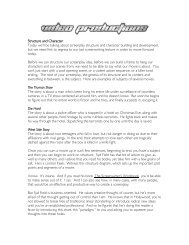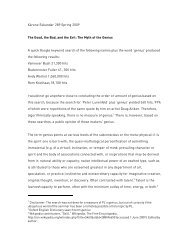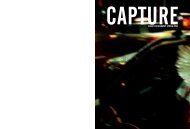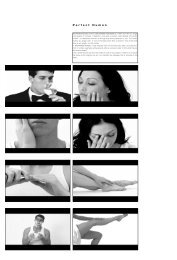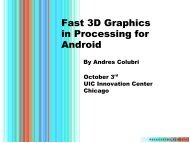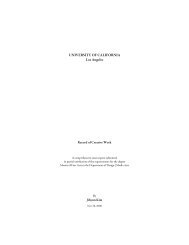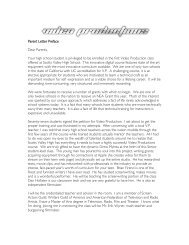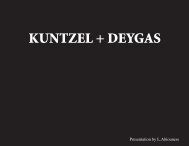Singing cells, art, science and the noise in between - Users - UCLA
Singing cells, art, science and the noise in between - Users - UCLA
Singing cells, art, science and the noise in between - Users - UCLA
Create successful ePaper yourself
Turn your PDF publications into a flip-book with our unique Google optimized e-Paper software.
C. P. Snow described <strong>the</strong> separation <strong>between</strong> <strong>the</strong> <strong>science</strong>s <strong>and</strong> humanities, caused by <strong>the</strong><br />
<strong>in</strong>dustrial <strong>and</strong> scientific revolutions, <strong>in</strong> his famous <strong>and</strong> controversial lecture of 1959 titled<br />
The two cultures. By depict<strong>in</strong>g <strong>the</strong> two discipl<strong>in</strong>es as isolated from each o<strong>the</strong>r <strong>and</strong><br />
ignorant of each o<strong>the</strong>r, Snow st<strong>art</strong>ed an ongo<strong>in</strong>g public debate about <strong>the</strong> polarization of<br />
<strong>the</strong> community of scientists <strong>and</strong> <strong>the</strong> community of <strong>in</strong>tellectuals of <strong>the</strong> literary <strong>and</strong> <strong>art</strong>istic<br />
world. The two cultures caused a flood of discussions about <strong>the</strong> verity <strong>and</strong> severity of his<br />
dramatic portrayal, lead<strong>in</strong>g to a dist<strong>in</strong>guished analysis of <strong>the</strong> orig<strong>in</strong>s of this polarization.<br />
The generally accepted division of <strong>the</strong> <strong>art</strong>s <strong>and</strong> <strong>science</strong>s did not necessarily h<strong>in</strong>der<br />
<strong>in</strong>dividuals <strong>in</strong> <strong>the</strong>ir <strong>in</strong>terdiscipl<strong>in</strong>ary pursuits, as is well exemplified by Johann Wolfgang<br />
von Goe<strong>the</strong> (1749-1832), one of <strong>the</strong> most versatile <strong>art</strong>ists of <strong>the</strong> Romantic period. But <strong>the</strong><br />
concept of specialization <strong>in</strong>fluenced <strong>the</strong> public’s perception of <strong>the</strong> work <strong>and</strong> research of<br />
<strong>the</strong>se <strong>in</strong>dividuals. Goe<strong>the</strong>, who himself dedicated much of his time to optical research, is<br />
ma<strong>in</strong>ly credited for his literary work. As poet, novelist, playwrite, <strong>and</strong> natural<br />
philosopher, he was <strong>in</strong>terested <strong>in</strong> a great variety of studies <strong>and</strong> pursuits throughout his<br />
life. He made important discoveries <strong>in</strong> connection with plant <strong>and</strong> animal life, <strong>and</strong><br />
competed <strong>in</strong> <strong>science</strong> by evolv<strong>in</strong>g a non-Newtonian <strong>the</strong>ory of <strong>the</strong> character of light, with<br />
which he earned <strong>the</strong> suspicion of <strong>the</strong> scientific community. It is said that Goe<strong>the</strong><br />
considered his color studies, summarized <strong>in</strong> <strong>the</strong> extensive volumes titled Zur<br />
Farbenlehre, more important than all of his poetic works. 15<br />
To demonstrate <strong>the</strong> animosity present <strong>in</strong> <strong>the</strong> relationship <strong>between</strong> <strong>the</strong> humanities <strong>and</strong><br />
<strong>science</strong> <strong>in</strong> <strong>the</strong> 18 th century, Arthur Zajonc recounts <strong>the</strong> story of <strong>the</strong> “unweav<strong>in</strong>g of <strong>the</strong><br />
ra<strong>in</strong>bow”. 16 The ra<strong>in</strong>bow has always been a significant metaphor <strong>in</strong> religion <strong>and</strong><br />
spirituality, <strong>and</strong> has enchanted <strong>the</strong> human m<strong>in</strong>d s<strong>in</strong>ce earliest ages. Accord<strong>in</strong>g to his book<br />
Catch<strong>in</strong>g <strong>the</strong> light: <strong>the</strong> entw<strong>in</strong>ed history of light <strong>and</strong> m<strong>in</strong>d, Isaac Newton’s experimental<br />
observations concern<strong>in</strong>g <strong>the</strong> refraction of light <strong>in</strong> <strong>the</strong> late 17 th century f<strong>in</strong>ally allowed a<br />
scientifically satisfactory explanation of <strong>the</strong> ra<strong>in</strong>bow phenomena. This caused an uproar<br />
among <strong>the</strong> literati of <strong>the</strong> time, who hurled many accusations towards <strong>the</strong> scientific world.<br />
Zajonc describes <strong>in</strong>cidents that exemplify <strong>the</strong> swirl<strong>in</strong>g emotions of Romantic he<strong>art</strong>s “who<br />
saw <strong>in</strong> <strong>the</strong> triumph of optics over <strong>the</strong> ra<strong>in</strong>bow <strong>the</strong> death of poetic sensibilities”.<br />
For <strong>in</strong>stance <strong>the</strong> writers John Keats <strong>and</strong> Charles Lamb “agreed that he [Newton] had<br />
destroyed all <strong>the</strong> poetry of <strong>the</strong> ra<strong>in</strong>bow by reduc<strong>in</strong>g it to its prismatic colors”.<br />
Despite scientific explanation, <strong>the</strong> ra<strong>in</strong>bow did not lose its ability to enchant <strong>and</strong> provoke<br />
philosophical thoughts. In <strong>the</strong> <strong>in</strong>troduction of Our Ra<strong>in</strong>bow World, Otto E. Roessler <strong>and</strong><br />
Peter Weibel discuss objective reality <strong>and</strong> <strong>the</strong> role of <strong>the</strong> observer by reflect<strong>in</strong>g on <strong>the</strong> old<br />
say<strong>in</strong>g “a ra<strong>in</strong>bow’s ends st<strong>and</strong> <strong>in</strong> a pot of gold”. 17<br />
15 Johann Wolfgang von Goe<strong>the</strong>’s Zur Farbenlehre was first published <strong>in</strong> 1810 <strong>and</strong> consisted of 3 volumes<br />
compris<strong>in</strong>g 1400 pages.<br />
16 Catch<strong>in</strong>g <strong>the</strong> light: <strong>the</strong> entw<strong>in</strong>ed history of light <strong>and</strong> m<strong>in</strong>d, Arthur Zajonc, New York: Oxford University<br />
Press, 1995, p. 164 ff<br />
17 Unsere Regenbogenwelt, by Otto E. Roessler <strong>and</strong> Peter Weibel <strong>in</strong> Endo und Nano, Ars Electronica 1992,<br />
L<strong>in</strong>z: PVS Verleger, 1992, p. 13<br />
5



